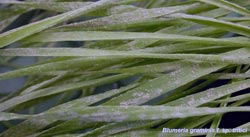Sexual reproduction only second choice for powdery mildew

Powdery mildew on young wheat plants. <br>Picture: UZH
Asexual reproduction, however, is considerably more successful for mildew, as plant biologists from the University of Zurich and the Max Planck Institute for Plant Breeding Research in Cologne demonstrate. Nonetheless, the fungus still allows itself a sexual reproduction cycle.
Powdery mildew is one of the most dreaded plant diseases: The parasitic fungus afflicts crops such as wheat and barley and is responsible for large harvest shortfalls every year. Beat Keller and Thomas Wicker, both plant biologists from the University of Zurich, and their team have been analyzing the genetic material of wheat mildew varieties from Switzerland, England and Israel while the team headed by Paul Schulze-Lefert at the Max Planck Institute for Plant Breeding Research in Cologne studies the genetic material of barley mildew.
The results recently published in Nature Genetics and PNAS respectively unveil a long shared history of co-evolution between the host and the pest and the unexpected success of asexually produced mildew offspring. Moreover, the data provides fresh insights into the crop history of wheat and barley and their interaction with the mildew pathogen.
Asexually produced offspring more successful
Like other fungi, mildew reproduces in two ways: Sexually, where the genetic material is recombined, and asexually, where the offspring and the mother fungus are genetically identical. The researchers now demonstrate that the success of the two reproduction methods could not be more different: “Mildew fungi detected on afflicted host plants have only successfully reproduced sexually every few centuries, primarily reproducing asexually instead,” explains Wicker.
This baffling fact has more deep-rooted causes: In order to infect the host plant, the mildew fungus needs to be able to successfully disable the plant’s defense mechanisms – the parasite has to be perfectly adapted to its host. “In a parasite-host situation, new combinations of genetic material are a disadvantage for the parasite as the adaptation to the host and its defense mechanisms deteriorates as a result.” Genetically identical offspring of successful mildew fungi that have already been able to infect the host plant, however, have the ideal genetic prerequisites to be able to attack a host themselves. According to Schulze-Lefert, wheat and barley mildew offspring from asexual reproduction are normally more successful than their sexually reproduced counterparts. Asexual reproduction as a success model seems to be characteristic of many parasitic fungi, including those that afflict humans, such as athlete’s foot.
Sex still worthwhile
Based on the gene analyses, the scientists were also able to prove that mildew already lived parasitically on the ancestral form of wheat 10,000 years ago, before wheat were actually domesticated as crops. None of the subsequent genetic changes in the crops due to breeding or spontaneous mutations was ever able to keep the mildew fungus away from wheat in the longer term. And this is precisely where the advantage of sexual reproduction lies and why the usually unsuccessful sexual reproduction cycle is still worthwhile for the mildew fungus: Wheat and mildew are embroiled in a permanent evolutionary arms race. “If wheat improves its defense mechanisms against the parasites, the fungus has to be able to follow suit or it has lost,” explains Wicker. “That’s only possible by recombining the genetic material; in other words, sexual reproduction.”
Evidently, a sexual exchange and mixtures of the genetic material of different mildew varieties have occurred several times in the course of the millennia, giving rise to new mildew varieties that were able to attack new sorts of wheat. The scientists suspect that the grain trade in the ancient world was partly responsible for the emergence of new mildew varieties.
Literature:
Thomas Wicker et al. The wheat powdery mildew genome shows the unique evolution of an obligate biotroph. Nature Genetics. July 14, 2013. doi:10.1038/ng.2704
Stéphane Hacquard et al. Mosaic genome structure of the barley powdery mildew pathogen and conservation of transcriptional programs in divergent hosts. PNAS. May 21, 2013. doi/10.1073/pnas130607110
Contact:
Wheat mildew:
Prof. Dr. Beat Keller
Institute of Plant Biology
University of Zurich
Tel. +41 44 634 82 30
E-Mail: bkeller@botinst.uzh.ch
Nathalie Huber
Media Relations
University of Zurich
Tel. +41 44 634 44 64
E-Mail: nathalie.huber@kommunikation.uzh.ch
Barley mildew:
Prof. Dr. Paul Schulze-Lefert
Max Planck Institute for Plant Breeding Research
50829 Cologne
Germany
Tel. +49 221 5062 350
E-Mail: schlef@mpiz-koeln.mpg.de
Media Contact
More Information:
http://www.uzh.chAll latest news from the category: Life Sciences and Chemistry
Articles and reports from the Life Sciences and chemistry area deal with applied and basic research into modern biology, chemistry and human medicine.
Valuable information can be found on a range of life sciences fields including bacteriology, biochemistry, bionics, bioinformatics, biophysics, biotechnology, genetics, geobotany, human biology, marine biology, microbiology, molecular biology, cellular biology, zoology, bioinorganic chemistry, microchemistry and environmental chemistry.
Newest articles

Bringing bio-inspired robots to life
Nebraska researcher Eric Markvicka gets NSF CAREER Award to pursue manufacture of novel materials for soft robotics and stretchable electronics. Engineers are increasingly eager to develop robots that mimic the…

Bella moths use poison to attract mates
Scientists are closer to finding out how. Pyrrolizidine alkaloids are as bitter and toxic as they are hard to pronounce. They’re produced by several different types of plants and are…

AI tool creates ‘synthetic’ images of cells
…for enhanced microscopy analysis. Observing individual cells through microscopes can reveal a range of important cell biological phenomena that frequently play a role in human diseases, but the process of…





















